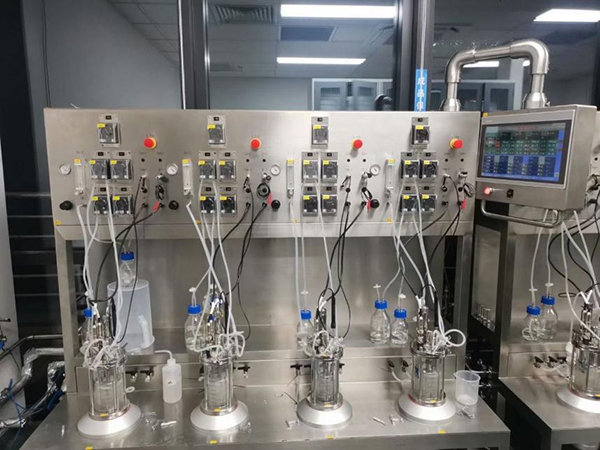The commonly used microorganisms and frequently encountered bacteria in industrial production are mainly bacteria, actinomycetes, yeast and mold. Due to the development of fermentation engineering itself and the entry of genetic engineering into the fermentation process, other microorganisms such as viruses and algae are also gradually becoming industrial production bacteria. This chapter mainly introduces the main microbial groups related to fermentation engineering.

https://www.sinotechmachinery.com/products/parallel-bioreactor/
1. Bacteria:
Bacteria are the most widely distributed and largest type of microorganisms in nature. They are single-cell prokaryotes with typical nuclear division or binary fission reproduction. They are tiny and can usually be seen under a 1000x optical microscope or electron microscope. The following are the commonly used bacteria in industrial production:
(1). Bacillus subtilis
Bacillus subtilis is an aerobic spore-forming bacterium. The vegetative cell is rod-shaped, and the size is generally 0.7~0.8×2~3μm. The bacterial end is semicircular. Single or in short chains. Spores are formed in the central part of the cell. The spores are oval or round, and the size is about 0.6~0.7×1.0~1.5μm. The spores germinate and split along the equator, which is the middle waist germination. The cell has flagella on the side and can move. Gram staining is positive. The growth temperature is 30~39℃, but it can still grow at 50 and 56℃. The optimal pH is 6.7~7.2. It is a spore-forming bacterium. The spores are resistant to high temperatures and can generally be killed at 100℃ for 3h.
(2). Escherichia coli
The cells are rod-shaped, with a length of 0.5×1.0~3.0μm. Some are nearly spherical, while others are long rod-shaped. Gram staining is negative. They can move or not move. Those that move have flagella around their body. Many species produce capsules or microcapsules and no spores.
Escherichia coli ferments glucose and lactose to produce acid and gas. The glutamate decarboxylase of Escherichia coli is used in industry for quantitative analysis of glutamate. Escherichia coli can also be used to produce aspartic acid, threonine and valine. In medicine and genetic engineering, Escherichia coli is a good research material.
(3). Lactobacillus
The cells are rod-shaped to spherical. They often grow in chains, mostly immotile, and those that can move have peritrichous flagella. Gram staining is positive. There are no spores. Normal colonies are rough. They ferment carbohydrates, and more than 85% of the products are lactic acid. They are anaerobic or facultative anaerobic. The growth temperature is 45-50℃.
The commonly used Lactobacillus delbrueckii is rod-shaped, with a size of 0.5-0.8×2.9μm. It reproduces particularly vigorously in malt saccharification liquid. The bacteria are fat and have a particularly strong acid production ability. On solid culture media, the colonies are tiny. In broth culture media, they are slightly turbid.
(4). Clos. acetobutyleum
The cells are rod-shaped, with round ends, 0.6-0.7×2.6-4.7μm, and the spore capsules are 1.3-1.6×4.7-5.5μm. Solitary or paired, but not in chains. The spores are oval, mesogenic or subterminal, making the spore capsule swell into a fusiform or drumstick shape. No capsule. Moves with peritrichum. With starch granules. Gram staining is positive and may become negative. Forms round, tightly raised colonies on glucose agar, creamy, opaque, and liquefies gelatin. Can ferment a variety of sugars, including starch, dextrin, etc.
It is mostly used to produce acetone butanol in production. The optimum temperature for fermentation is 30~32℃, the optimum temperature for growth is 37℃, and the optimum pH is 6.0~7.0.
(5). Leuconostoc mesenteroides
The cells are spherical or biconvex, with a size of 0.5~0.7×0.7~1.2μm, in pairs or chains, often arranged in short chains. Gram staining is positive, the colonies are small, grayish white, raised, and do not liquefy gelatin.
The growth temperature of this fungus is between 10 and 37 degrees Celsius, and the optimum temperature is 20 to 30 degrees Celsius. Because it often makes sugar juice sticky and unable to be processed, it is a harmful fungus in sugar factories.
(6). Acetobacter
The cells are oval to rod-shaped, 0.6~0.8×1.0~3.0μm. There are single, paired, and chain cells. In old cultures, they are prone to various deformed cells, such as filamentous, ladder-shaped, curved, etc. There are two types of flagella, one is peritrichous flagella and the other is terminal flagella. No spores are formed.
(7). Corynebacterium
The cells are rod-shaped, straight or slightly curved. They are often rod-shaped with one end swollen, broken and split. They are arranged in an "eight" shape or a palisade. They do not move, and only a few pathogenic bacteria can move. No spores. Gram staining is positive, and some are negative. The coloring in the cell is uneven, aerobic or anaerobic.
In the production of condiments, such as glutamic acid production, the commonly used bacteria are Beijing Corynebacterium (Corynebacterium pekinense). Its cells are usually short rods to small rods, sometimes slightly curved, with blunt ends and no branches. They are polymorphic, that is, the cells are elongated after 6 hours of culture. The cells are arranged in single, paired or "eight" shapes. The cell size is 0.7~0.9×1.0,2.5μm. They grow well when cultured at 26 and 37℃, and grow weakly at 41℃. They can grow at pH5~10, and the optimal pH is 6~7.5.
(8). Brivibacterium
The cells are short, unbranched straight rods, generally around 0.5~1.0×1.0,5 μm; most of them do not have flagella. They grow well on gravy peptone medium. Sometimes they produce water-insoluble pigments, which are red, orange-red, yellow, and brown. Gram staining is positive. They do not form spores. They are aerobic microorganisms. Most of them produce acid from glucose fermentation, but do not ferment lactose. Most of them liquefy gelatin and reduce litmus.
(9). Xanthomonas
The cells are straight rod-shaped; the two ends are blunt and slightly pointed; the size is 0.4~0.7×1.2~1.5μm. Gram staining is negative, there are no spores, and there are polar flagella. On agar plates containing sucrose, it can form round, neatly edged, sticky and smooth yellow colonies. In liquid culture, it forms a yellow sticky colloid-capsular polysaccharide, the yellow color of which is a non-water-soluble pigment.
Xanthomonas campestris can produce xanthan gum by fermentation with starch as a carbon source under aeration conditions at pH 6.8~7.0 and 28~30℃.
2. Yeast:
Yeast is a single-cell eukaryotic microorganism that is ubiquitous in nature and is mainly distributed in acidic environments with high sugar content, such as fruits, vegetables, nectar, plant leaves, and orchard soil. Yeasts are mostly saprophytic. The optimal growth temperature is 25~30℃. The following yeasts are commonly used in industry:
(1). Beer yeast (Saccharomyces cerevisiae)
Beer yeast is a species widely used in the genus Saccharomyces.
The cells of beer yeast grown on malt juice medium are round, oval or elliptical. The cells are solitary, twin or in short strings or clusters. The large yeast cells are about 5~10×6~12μm, and the small ones are about 3~9×4.5~10μm.
(2). Grape juice yeast (Saccharomyces uvarum)
Cultivated in malt juice at 25℃ for 3 days, the cell shape is oval, oval or sausage-shaped. The colony on malt juice agar medium is milky white, smooth, shiny, and has neat edges.
It can produce ascospores, with 1 to 4 spores in each ascus. The spores are round or oval with a smooth surface. This fungus has a strong fermentation ability and often appears turbid in liquid culture.
(3). Hansenula
The vegetative cells of this genus of yeast have various shapes, ranging from round, elliptical, oval, and sausage-shaped. They have multilateral budding. Some species can form pseudohyphae.
The shape of the ascus is the same as that of the vegetative cell. There are 1 to 4 ascospores, which are cap-shaped, Saturn-shaped, round, or semicircular, with a smooth surface.
(4). Toruiopsis
The cells of Toruiopsis are spherical and slightly elongated in egg form. They reproduce by multi-sided budding.
The colonies on the slant of malt juice are milky white, with wrinkled and dull surfaces, and neat or irregular edges. In liquid culture medium, sediment and yeast rings appear, and sometimes bacteria can also be produced.
(5). Candida
The cells are round, oval or long. They reproduce by multi-sided budding. They can form pseudohyphae. On malt juice agar medium, the colonies are milky white, smooth, shiny, with neat or hyphae edges. Liquid culture can form floating films.
They can ferment glucose, sucrose, and raffinose. They cannot ferment maltose, galactose, lactose, and melibiose. They do not decompose fats. They can assimilate nitrates.
(6). Pichia
The cells are oval, oblong or sausage-shaped, single or in short chains. They form ascospores by heteromorphic conjugation. Ascospores are oval. The colonies on malt agar are milky white, dull, and have fine notches on the edges. When cultured in malt wort, there are white, wrinkled, rough bacterial spores on the surface of the culture solution, and bacterial sediments at the bottom.
This bacterium has a weak ability to decompose sugar and does not produce alcohol. It can oxidize alcohol and can tolerate high or relatively high concentrations of alcohol. It often causes white blooms in wine and soy sauce and forms a floating film. It is a harmful bacterium in the brewing industry, such as powdery Pichia yeast.
(7). Red yeast (Rhodotorula)
The cells are round, oval or long. They have multilateral budding and obvious red or yellow pigments. Many species form viscous colonies due to capsules. There are strains in this genus that produce fat well, and a large amount of fat can be extracted from the bacteria. Some species have a weak oxidation effect on hydrocarbons and can synthesize β-carotene. For example, the red yeast red variety can oxidize alkanes to produce fat, and the content can reach 50~60% of the dry biomass. Under certain conditions, it can also produce α-alanine and glutamic acid, and the ability to produce methionine is also very strong, which can reach 1% of the dry biomass.
(8). Nematspora gossypii
Also known as cotton cyst mold. It grows well at 26℃ on malt juice and potato culture medium. At the beginning, the moist creeping hyphae spread and grow; the colony is colorless or off-white, gradually turns light yellow after 2-3 days, becomes lemon-orange after 5 days, and becomes yellow-green after 7-10 days due to the diffusion of riboflavin around the colony.
(9). Geotrichum candidum
Geotrichum candidum is a common species in the genus Geotrichum. It is fission-producing. The arthrospores are single or connected in chains, long cylindrical, square, or oval, with blunt ends. Most of the arthrospores are 4.9~9.6×5.4~16.6μm.
In malt juice, cultured at 28~30℃ for one day, white pulp is produced. It is fluffy or powdery, tough or brittle, and is fungal hyphae. The growth temperature is 33~37℃. It has weak fermentation of glucose, mannose, fructose, etc. It can assimilate glycerol, ethanol; sorbitol, mannitol. It can decompose pectin, oil, etc. It does not assimilate nitrates. The bacterial cells are rich in protein, fat, vitamins and a large amount of nucleic acid. It has the characteristics of strong adaptability, fast growth, large yield and simple cultivation method.

 English
English français
français Español
Español русский
русский português
português العربية
العربية




